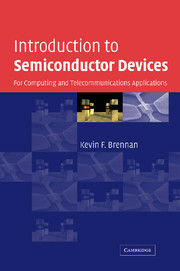Book contents
- Frontmatter
- Contents
- Preface
- List of physical constants
- List of materials parameters for important semiconductors, Si and GaAs
- 1 Semiconductor fundamentals
- 2 Carrier action
- 3 Junctions
- 4 Bipolar junction transistors
- 5 JFETs and MESFETs
- 6 Metal–insulator–semiconductor structures and MOSFETS
- 7 Short-channel effects and challenges to CMOS
- 8 Beyond CMOS
- 9 Telecommunications systems–an overview
- 10 Optoelectronic devices – emitters, light amplifiers, and detectors
- 11 Transistors for high frequency, high power amplifiers for wireless systems
- References
- Index
6 - Metal–insulator–semiconductor structures and MOSFETS
Published online by Cambridge University Press: 05 June 2012
- Frontmatter
- Contents
- Preface
- List of physical constants
- List of materials parameters for important semiconductors, Si and GaAs
- 1 Semiconductor fundamentals
- 2 Carrier action
- 3 Junctions
- 4 Bipolar junction transistors
- 5 JFETs and MESFETs
- 6 Metal–insulator–semiconductor structures and MOSFETS
- 7 Short-channel effects and challenges to CMOS
- 8 Beyond CMOS
- 9 Telecommunications systems–an overview
- 10 Optoelectronic devices – emitters, light amplifiers, and detectors
- 11 Transistors for high frequency, high power amplifiers for wireless systems
- References
- Index
Summary
In this chapter we discuss metal–insulator-semiconductor, MIS, structures. The most important MIS structure is the metal-oxide-semiconductor, or MOS, structure. The MOS structure is used to provide gating action in MOSFETs. Here we will discuss both ideal and realistic systems and examine their behavior both in equilibrium and under bias. The chapter concludes with a discussion of the workings of MOSFETs.
MIS systems in equilibrium
The basic device structure of interest is sketched in Fig. 6.1. Inspection of Fig. 6.1 shows that the MIS structure consists of three different layers: metal, insulator, and semiconductor layers. In this section we examine the operation of MIS systems in equilibrium. We start with a discussion of ideal MIS systems that have the following properties:
(i) The metal–semiconductor work function difference, ϕms, is zero at zero applied bias.
(ii) The insulator is perfect; it has zero conductivity, σ = 0.
(iii) No interface states located at the semiconductor–oxide interface are assumed to exist.
(iv) The semiconductor is uniformly doped.
(v) There is a field free region between the semiconductor and the back contact. In other words, there is no voltage drop within the bulk semiconductor.
(vi) The structure is essentially one-dimensional.
(vii) The metal gate can be treated as an equipotential surface.
To draw the band diagram of the MIS structure in equilibrium we first recognize that the Fermi level must be flat everywhere in the structure as shown in Fig. 6.2.
- Type
- Chapter
- Information
- Introduction to Semiconductor DevicesFor Computing and Telecommunications Applications, pp. 127 - 168Publisher: Cambridge University PressPrint publication year: 2005



